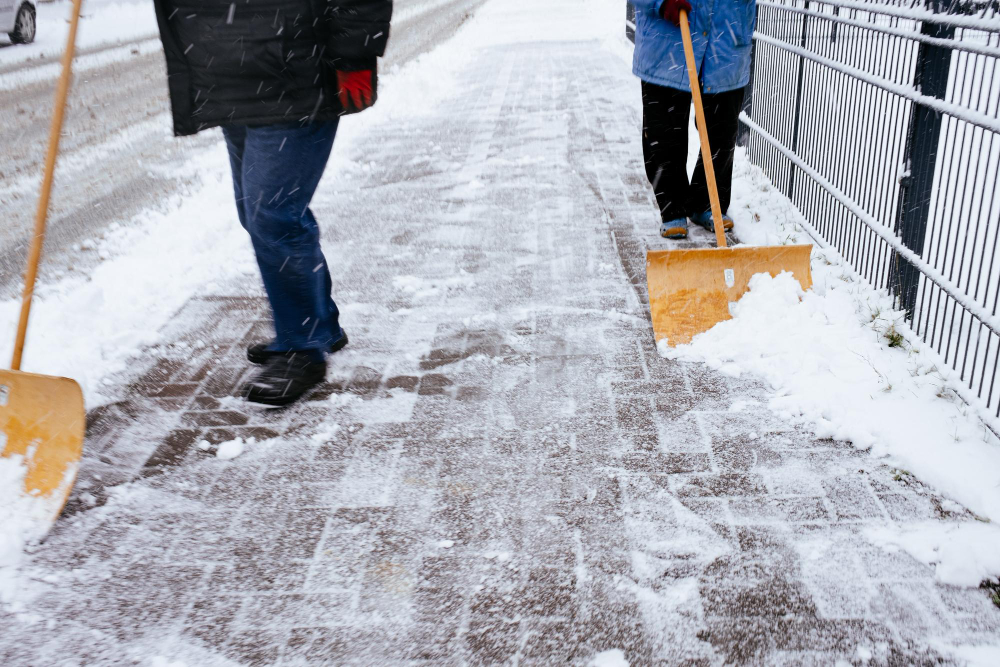Can Safe Paw or Safe Thaw Damage Well-Sealed Concrete? Here’s What You Need to Know

When winter weather arrives, many homeowners wonder if using ice melt—even pet-safe varieties—can still harm their concrete surfaces, even after they’ve been sealed. It’s a fair question, especially if you’re proactive about sealing your concrete every year. The answer? If your sealer is high-quality and applied correctly, products like Safe Paw or Safe Thaw will not damage your concrete.
But there’s more to the story.
Sealing is only one part of the equation. The effectiveness of that seal depends on factors like the age of your concrete, how clean the surface was during application, and even the outdoor temperature at the time of sealing. Poor application or low-grade sealers may give a false sense of protection, leaving the surface vulnerable to water penetration and subsequent freeze-thaw damage. Using a non-corrosive, chloride-free deicer is a smart move, but it works best in tandem with proper surface preparation and annual upkeep.
The Role of Sealers in Concrete Protection
A concrete sealer acts as a barrier, helping to prevent water from entering the surface. This is critical during winter because water that seeps into concrete can freeze and expand, causing cracks, scaling, and deterioration through what’s known as the freeze-thaw cycle.
However, not all sealers are created equal. Many commercial products promise long-term protection but fail to deliver. A subpar sealer can leave your concrete vulnerable—even if it was applied diligently. Likewise, how and when the sealer is applied plays a vital role. If applied too late in the season or under poor conditions (like cold or damp weather), its effectiveness drops significantly.
Do Safe Paw and Safe Thaw Harm Sealed Concrete?
In properly sealed, well-maintained concrete, the answer is no. Products like Safe Paw and Safe Thaw are chloride-free and formulated to minimize damage risks. Unlike traditional rock salt and chloride blends, these products do not aggressively interact with the concrete’s surface or its internal structure.
That said, even the best ice melt can’t completely protect poorly sealed or poorly cured concrete. For concrete to fully mature and reach its maximum strength, it needs about 12 months. During that time, applying a reliable sealer—and reapplying it regularly—can help safeguard your investment from moisture, deicers, and wear.
A Word About Freeze-Thaw Cycles
Even the strongest concrete is still vulnerable to nature’s freeze-thaw process. While Safe Paw and Safe Thaw do not cause freeze-thaw cycles, they can’t stop them either. A high-quality sealer helps by limiting how much moisture seeps in—but if moisture finds a way below the surface, freeze-thaw expansion can still cause surface flaking or scaling. This is why pairing good sealing habits with non-corrosive ice melt is the best defense.
Conclusion: It’s About Quality and Timing
Using Safe Paw or Safe Thaw on well-sealed concrete won’t cause damage—if the sealer is quality and applied correctly. Your results depend not just on the ice melt but also on your concrete’s cure time, the integrity of the sealer, and how well it’s maintained over the seasons. Reapplying sealer yearly and using non-corrosive, chloride-free products is a safe, long-term strategy for protecting your concrete investment during harsh winters.
Frequently Asked Questions
Q1: Can Safe Paw or Safe Thaw damage new concrete that’s less than a year old?
A1: New concrete is more vulnerable. While Safe Paw and Safe Thaw are safer than traditional salts, newly poured concrete should be cured for at least 12 months before exposure.
Q2: How often should concrete be sealed?
A2: Ideally, concrete should be sealed every year—especially in climates with harsh winters or heavy freeze-thaw activity.
Q3: What makes a sealer high-quality?
A3: A high-quality sealer will penetrate the surface, resist UV breakdown, and prevent moisture penetration. Look for products rated for freeze-thaw protection and chloride resistance.
Q4: Will Safe Thaw still be safe if the sealer starts to wear off mid-winter?
A4: Safe Thaw is non-corrosive and will not aggressively attack concrete, but resealing before winter ensures maximum surface protection.
Q5: Can I apply a sealer in winter?
A5: No, sealers should be applied in dry, mild conditions—typically spring or fall. Cold or damp weather prevents proper curing and bonding.